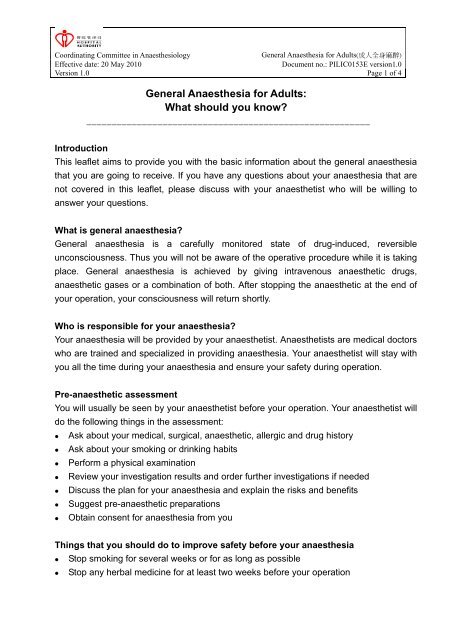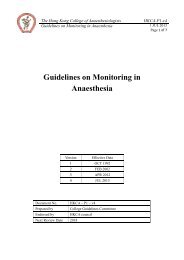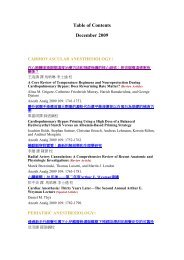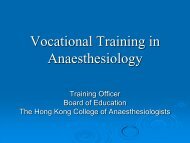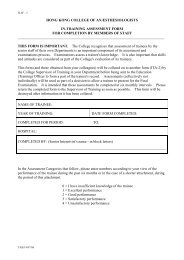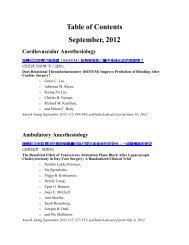Patient Information Leaflet For Informed Consent
Patient Information Leaflet For Informed Consent
Patient Information Leaflet For Informed Consent
You also want an ePaper? Increase the reach of your titles
YUMPU automatically turns print PDFs into web optimized ePapers that Google loves.
Coordinating Committee in Anaesthesiology General Anaesthesia for Adults( 成 人 全 身 麻 醉 )Effective date: 20 May 2010Document no.: PILIC0153E version1.0Version 1.0 Page 1 of 4General Anaesthesia for Adults:What should you know?________________________________________________________IntroductionThis leaflet aims to provide you with the basic information about the general anaesthesiathat you are going to receive. If you have any questions about your anaesthesia that arenot covered in this leaflet, please discuss with your anaesthetist who will be willing toanswer your questions.What is general anaesthesia?General anaesthesia is a carefully monitored state of drug-induced, reversibleunconsciousness. Thus you will not be aware of the operative procedure while it is takingplace. General anaesthesia is achieved by giving intravenous anaesthetic drugs,anaesthetic gases or a combination of both. After stopping the anaesthetic at the end ofyour operation, your consciousness will return shortly.Who is responsible for your anaesthesia?Your anaesthesia will be provided by your anaesthetist. Anaesthetists are medical doctorswho are trained and specialized in providing anaesthesia. Your anaesthetist will stay withyou all the time during your anaesthesia and ensure your safety during operation.Pre-anaesthetic assessmentYou will usually be seen by your anaesthetist before your operation. Your anaesthetist willdo the following things in the assessment:• Ask about your medical, surgical, anaesthetic, allergic and drug history• Ask about your smoking or drinking habits• Perform a physical examination• Review your investigation results and order further investigations if needed• Discuss the plan for your anaesthesia and explain the risks and benefits• Suggest pre-anaesthetic preparations• Obtain consent for anaesthesia from youThings that you should do to improve safety before your anaesthesia• Stop smoking for several weeks or for as long as possible• Stop any herbal medicine for at least two weeks before your operation
Coordinating Committee in Anaesthesiology General Anaesthesia for Adults( 成 人 全 身 麻 醉 )Effective date: 20 May 2010Document no.: PILIC0153E version1.0Version 1.0 Page 2 of 4• See a dentist for treatment if you have any loose teeth or crowns• Stop certain types of medication according to the advice of your anaesthetistFasting before operation• In order to prevent aspiration of food or liquid into your lungs during anaesthesia,you should not eat or drink for at least 6 hours before your operation: known as‘fasting’. Fasting usually starts from midnight if you are scheduled to have youroperation the following morning, or from 7 a.m. if you are scheduled to have youroperation in the afternoon of that day. The hospital will give you clear instructionsabout fasting and you should follow them.• If you have an emergency operation, a special anaesthetic technique will be usedto reduce the risk of aspirationYour usual medicationsYour anaesthetist will advise you on which usual medications you should or shouldnot take on the day of your operation. You should follow these instructions. You areallowed to take your medications with a mouthful of water while you are fasting.Examples of medication that should be stopped before your operation:• Oral medications for diabetes• Anticoagulants: medications used to ‘thin’ your blood to prevent clotting, forexample, aspirin, warfarin, clopidogrelWhat should you do if you feel unwell on the day of operation?Please inform the hospital if you feel unwell on the day of your operation. In order toreduce unnecessary risks, your operation may need to be postponed until you feelbetter.On the day of operation• In the theatre, your anaesthetist, surgeon and operation nursing staff will checkyour identity, the type of operation, the site of operation and the type ofanaesthesia before the procedure. This is to ensure that you are the right patientand your planned surgery and anaesthesia are correct; we call this finalverification process as ‘time out’• Various monitors will be attached to you. The complexity of the monitoringdepends on your medical condition and the type of operation. Sometimes invasivemonitoring like placing a plastic catheter/tubing into one of your large veins or
Coordinating Committee in Anaesthesiology General Anaesthesia for Adults( 成 人 全 身 麻 醉 )Effective date: 20 May 2010Document no.: PILIC0153E version1.0Version 1.0 Page 3 of 4arteries may be needed• Your anaesthetist will insert a plastic catheter/tubing into your vein. Through thisyour anaesthetist will inject medications including anaesthetic drugs.• As a part of your anaesthetic, the anaesthetist may have to control your airwayand breathing. He may need to insert a plastic tube (called endotracheal tube)through your mouth into your windpipe, or other alternative equipment to maintainthe patency of your airway and to ensure adequate respiration.• Your anaesthetist/s will stay with you at all times to give you anaesthesia, monitoryour vital signs, give you treatment as necessary and ensure your safety• As soon as the operation is finished, the anaesthetic drugs will be stopped orreversed and you will regain consciousness• Depending on the clinical condition, some patients may need to be kept asleepand ventilated with the help of a machine after the operation; for example, aftersome major operationsPain reliefYou will be given pain relieving drugs during your operation and when necessary inthe recovery room. The anaesthetist will discuss with you during the pre-anaestheticassessment when special types of pain relieving methods are considered.Examples of special pain management:• Local anaesthetic and regional blocks• Epidural analgesia• <strong>Patient</strong> controlled analgesiaIs there any risk in general anaesthesia?In general, modern anaesthesia is safe and risk of death directly associated withgeneral anesthesia is very small. The side effects and complications associated withgeneral anaesthesia can be divided into those that are very common, common,uncommon, and rare or very rare∗.∗ Reference of occurrence rateVery common Common Uncommon Rare Very rare1 in 10 1 in 100 1 in 1000 1 in 10,000 1 in 100,000
Coordinating Committee in Anaesthesiology General Anaesthesia for Adults( 成 人 全 身 麻 醉 )Effective date: 20 May 2010Document no.: PILIC0153E version1.0Version 1.0 Page 4 of 4Very common and common side effects• Nausea and vomiting • Headache• Sore throat • Itching• Dizziness, blurred vision • Bruising and soreness• Aches, pain and backache • Short term confusion or memory loss• Pain during injection of drugsUncommon side effects and complications• Aspiration of stomach contents / othermatter into the lungs• Awareness: being awake during thesurgery in certain high risk patients• Depressed breathing • Stroke• Failure to intubate • Heart attackRare or very rare complications• Damage to eyes • Nerve damage• Serious allergy to drugs • Complications of invasive line insertion• Death (0.61 per 10,000 anaesthetics inHospital Authority between 2003-2005)RemarksThis is general information only and the list of complications is not exhaustive. Otherunforeseen complications may occasionally occur. In special patient groups, theactual risk may be different. <strong>For</strong> further information please contact your anaesthetist.Complications may sometimes occur despite all precautions. However, if they dooccur, your anaesthetist will take appropriate steps to manage them.


